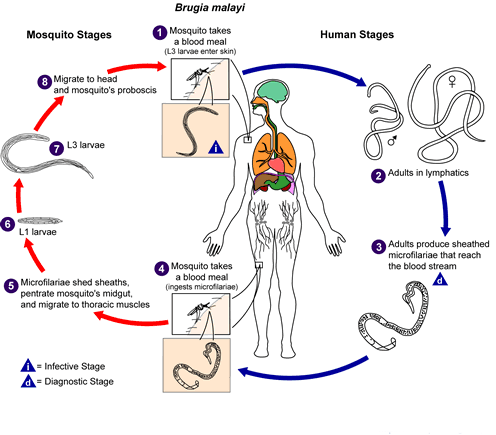Brugia malayi LifeCycle
Författare/Upphovsman:
Okänd
Kort länk:
Källa:
Upplösning:
496 x 435 Pixel (33282 Bytes)
Beskrivning:
Filariasis
Life cycle of Brugia malayi
The typical vector for Brugia malayi filariasis are mosquito species from the genera Mansonia and Aedes. During a blood meal, an infected mosquito introduces third-stage filarial larvae onto the skin of the human host, where they penetrate into the bite wound. They develop into adults that commonly reside in the lymphatics. The adult worms resemble those of Wuchereria bancrofti but are smaller. Female worms measure 43 to 55 mm in length by 130 to 170 μm in width, and males measure 13 to 23 mm in length by 70 to 80 μm in width. Adults produce microfilariae, measuring 177 to 230 μm in length and 5 to 7 μm in width, which are sheathed and have nocturnal periodicity. The microfilariae migrate into lymph and enter the blood stream reaching the peripheral blood. A mosquito ingests the microfilariae during a blood meal. After ingestion, the microfilariae lose their sheaths and work their way through the wall of the proventriculus and cardiac portion of the midgut to reach the thoracic muscles. There the microfilariae develop into first-stage larvae and subsequently into third-stage larvae. The third-stage larvae migrate through the hemocoel to the mosquito's prosbocis and can infect another human when the mosquito takes a blood meal.
Licens:
Public domain
Licenskommentaren:
This image is a work of the Centers for Disease Control and Prevention, part of the United States Department of Health and Human Services, taken or made as part of an employee's official duties. As a work of the U.S. federal government, the image is in the public domain.
Mer information om licensen för bilden finns här. Senaste uppdateringen: Wed, 02 Oct 2024 08:44:04 GMT
